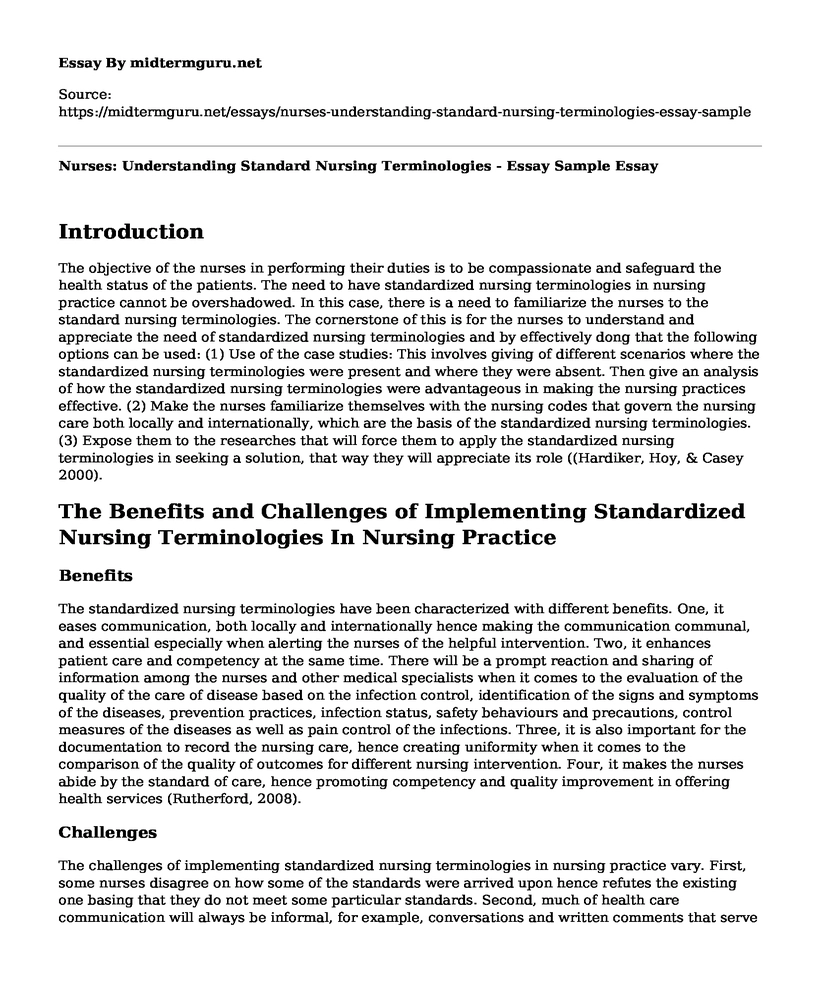Introduction
The objective of the nurses in performing their duties is to be compassionate and safeguard the health status of the patients. The need to have standardized nursing terminologies in nursing practice cannot be overshadowed. In this case, there is a need to familiarize the nurses to the standard nursing terminologies. The cornerstone of this is for the nurses to understand and appreciate the need of standardized nursing terminologies and by effectively dong that the following options can be used: (1) Use of the case studies: This involves giving of different scenarios where the standardized nursing terminologies were present and where they were absent. Then give an analysis of how the standardized nursing terminologies were advantageous in making the nursing practices effective. (2) Make the nurses familiarize themselves with the nursing codes that govern the nursing care both locally and internationally, which are the basis of the standardized nursing terminologies. (3) Expose them to the researches that will force them to apply the standardized nursing terminologies in seeking a solution, that way they will appreciate its role ((Hardiker, Hoy, & Casey 2000).
The Benefits and Challenges of Implementing Standardized Nursing Terminologies In Nursing Practice
Benefits
The standardized nursing terminologies have been characterized with different benefits. One, it eases communication, both locally and internationally hence making the communication communal, and essential especially when alerting the nurses of the helpful intervention. Two, it enhances patient care and competency at the same time. There will be a prompt reaction and sharing of information among the nurses and other medical specialists when it comes to the evaluation of the quality of the care of disease based on the infection control, identification of the signs and symptoms of the diseases, prevention practices, infection status, safety behaviours and precautions, control measures of the diseases as well as pain control of the infections. Three, it is also important for the documentation to record the nursing care, hence creating uniformity when it comes to the comparison of the quality of outcomes for different nursing intervention. Four, it makes the nurses abide by the standard of care, hence promoting competency and quality improvement in offering health services (Rutherford, 2008).
Challenges
The challenges of implementing standardized nursing terminologies in nursing practice vary. First, some nurses disagree on how some of the standards were arrived upon hence refutes the existing one basing that they do not meet some particular standards. Second, much of health care communication will always be informal, for example, conversations and written comments that serve some short-term purpose. The challenge is to identify where formalization is not just feasible but desirable. Third, standardization is subject, of course, to more pragmatic constraints, in that it requires considerable resources and scarce expertise. This will necessarily limit the aims of the process. Fourth, once an appropriate scope has been established, the issue of granularity arises (Hardiker, Hoy, & Casey 2000).
References
Hardiker, N. R., Hoy, D., & Casey, A. (2000). Standards for nursing terminology. Journal of the American Medical Informatics Association, 7(6), 523-528. doi:10.1136/jamia.2000.0070523
Rutherford, M. (2008). Standardized nursing language: What does it mean for nursing practice. OJIN: The Online Journal of Issues in Nursing, 13(1), 243-50. Doi: 10.3912/OJIN.Vol13No01PPT05
Cite this page
Nurses: Understanding Standard Nursing Terminologies - Essay Sample. (2023, Jan 16). Retrieved from https://midtermguru.com/essays/nurses-understanding-standard-nursing-terminologies-essay-sample
If you are the original author of this essay and no longer wish to have it published on the midtermguru.com website, please click below to request its removal:
- Statistics Paper Example: Sampling Distribution
- Therapeutic Relationship in Nursing Practice - Nursing Essay Sample
- Essay on Creating a Flowchart in Healthcare
- Community Awareness on Children with Autism - Paper Example
- During American civil war, the North had historically been identified as states that were free and ones which opposed Confederacy and slavery. The struggle against secession as well as slavery obscured the reality. As early as 1796, the terms South and North were used as a warning against dangers of political differences which existed bringing forth prevalence of unions in the North more than the South. In the North, West, and Midwest states, development was majorly characterized by a system of agricultural diversity, commercial vigor, and free labor. Towards the end of World War 11, labor and politics in the North West, and Midwest states were having a unionization rate of approximately 40 per cent (Timothy, 2006). The New Deal party was favoring formation of Unions unlike in the South. The party was also promoting formation and growth of bill of rights of the North economy and National health insurance. In the Southern, there was low unionization rate and also the political climate did not favor the formation of unions. The Southern reactionary politics had pulled the political economy of America to the right, hence becoming a barrier to the establishment of a social welfare style similar to that of Europe and also undermined the formation of unions and wages of unions in the South (Peter, 2017).
- Differential Diagnosis of Breast Cancer: Causes, Symptoms, and Treatment - Research Paper
- Case Study on Acute Coronary Heart Syndrome







